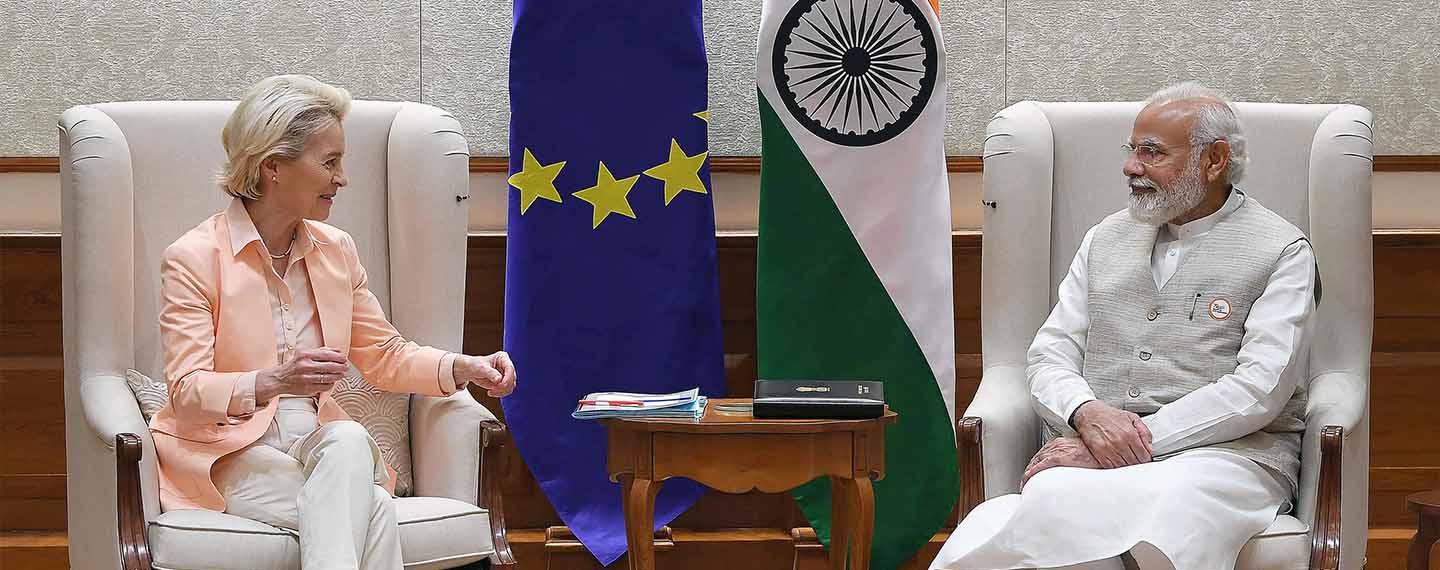Summary
The EU and India have launched a Trade and Technology Council (TTC), a bilateral forum to prioritise their partnership through cooperation in digital governance, green and clean energy technologies, and resilient value chains, trade and investment. The Council is a response to increasing great-power competition and a desire on both sides to bolster their respective strategic autonomies, with the potential to have a significant impact on the EU’s ambitions in the political, economic and technology spheres.
In a context of increasing great-power competition, the EU and India are aiming to mutually bolster their respective strategic autonomies. Ten months after its announcement in April 2022, Brussels and New Delhi have launched the Trade and Technology Council (TTC), highlighting their joint commitment to prioritise their partnership through a strategic engagement in trade and technology. The bilateral forum includes three working groups on cooperation in digital governance and connectivity, green and clean energy technologies, and resilient value chains, trade and investment.
The EU-India TTC opens up a new avenue for cooperation, and in turn entails a number of challenges and opportunities. At a time when the global governance of technology is being shaped by means of ad hoc coalitions and platforms for dialogue –but not yet through international organisations, with the particular exception to some extent of the ITU, the UN agency devoted to ICT governance–, this mechanism is the second of its kind initiated by the EU, the EU-US TTC being the first. It joins the growing list of regional-based initiatives that the EU is launching to address the impact of technology on security, economic(s) and values, such as the Digital Partnerships with Japan, the Republic of Korea and Singapore, the Joint Commitment to Digital Transformation in the EU-Africa Joint Vision for 2030, and the upcoming EU-LAC Digital Alliance, among others. It falls back on the goals envisioned by the first-ever approach to EU digital diplomacy, released a bare six months ago.
On the Indian side, the TTC is not the first institutionalised platform either. The Quad Initiative, formed by Australia, India, Japan and the US, is the main multilateral group addressing the strategic orientation of trade and technology in the Indo-Pacific. Furthermore, the Biden Administration recently launched a number of cooperation initiatives, including quantum computing, artificial intelligence, 5G wireless networks and semiconductors. The Initiative on Critical and Emerging Technologies is the latest move by the US to create alignments and to counter China.
The China factor in the EU-India TTC
It is the China factor that explains the EU’s impetus to cooperate with partners on a bilateral basis and not tri-laterally or multilaterally. The EU-US TTC’s work has so far focused mostly on information sharing, joint mapping, defining best practices, identifying risks and exploring options for closer cooperation. One of the main US goals at the early stage was to leverage the TTC as a space for dialogue on a common view vis-à-vis China, while for the EU the TTC is not about China.
That is why the EU has entered a new phase of bilateral cooperation with India on trade and technology. The key underlying motives behind a reignited cooperation between the two is the mirror effect from Sino-Russian alignment: while the EU seeks to decrease its reliance on China (although without an anti-China impulse), India aims to reduce its dependence on Russia and China.
The COVID-19 pandemic, the war in Ukraine and the structural competition between the US and China have further driven the EU to look at the world through a geopolitical lens, particularly on trade, and it is now applying a more realist(ic) assessment of weaponised interdependence. The EU’s open strategic autonomy is an expression of the shift in the thinking behind European policies. That is the reason why we are witnessing the EU arming itself with a toolbox that is expanding by the day in order to tackle economic distortions and security disruptions to supply chains and strategic technologies from China –but not only–.
On the other hand, while working on reducing its dependence on Russia from the military point of view, India has not yet condemned in overtly explicit terms the invasion of Ukraine. However, with China posing a military challenge at its borders and an undesirable military dependence on Russia, New Delhi is not in the most comfortable of situations. Such a quandary only provides a further incentive for India to increase its engagement with the EU.
Given the general trend towards reducing dependence on China in critical sectors, India has conducted several technology crackdowns on the country since at least 2020. It has either banned Chinese apps and services or subjected Chinese manufacturers to investigations from India’s Enforcement Directorate, which has seized bank accounts or accused many companies of tax evasion. Section 69 of the Indian Information Technology Act enables the Indian central government to block access –by invoking emergency powers– to any domain or app that is deemed to be a threat to national security.
Also, due to US sanctions and tighter export control regimes on Chinese semiconductors and other critical technologies, India has presented itself as the alternative for the location of multinationals such as Apple and Samsung, to diversify its supply chains away from China. India has been investing in its homegrown technology sector to build up its own economic and security statecraft thanks to both governmental support and public-private schemes in frontier-technology development.
Opportunities and the future ahead
In general, Europe still has a low awareness of the threat China poses for India and, more importantly, the dynamics of Sino-Indian relations. The greater the channels of cooperation with India, the greater the EU’s understanding of the Indian position and the opportunities to be had by engaging more broadly in the Indo-Pacific region.
Furthermore, there are a variety of attitudes and positions across the EU as to how to approach China, technology and trade policy from a security and geopolitical perspective. The Netherlands’ potential decision to join the US semiconductor export controls on China, alongside Japan, prove the extent to which there is a need for the EU as a bloc to agree on common views on critical issues. This will be paramount for the first and third working groups of the EU-India TTC, the former focusing on areas of mutual interest such as AI, 5G/6G, high performance and quantum computing, semiconductors, cloud systems, and cybersecurity, and the latter on efforts to supply chain resilience, access to critical components, and trade barrier and global trade challenge resolution.
However, there are several opportunities for the EU-India TTC. First, the forum’s institutionalisation will help both sides to bolster a strategic level of cooperation by combining long-term policy initiatives with short-term urgent responses when deemed necessary.
Ministerial meetings will take place at least once a year –the first is planned to be held in spring 2023–.
Second, it is likely for the EU to aim to keep the TTCs with the US and India as separate forums, but it will be important to keep an eye on possible cross-alignments at the working and policy levels –not so much at the political and diplomatic levels, given the different intensities and narratives vis-à-vis China–.
Third, the EU-India TTC might lead to the diversification of partners in the Indo-Pacific region. While the EU has separate digital external policy agendas with Japan, the Republic of Korea and Singapore by means of bilateral Digital Partnership Agreements, it is true that the sum of these initiatives might lead to some rapprochement, at least at the working level of information sharing, joint mapping and the definition of best practices, as is already the case with the EU-US TTC.
India possesses all the ingredients to have a significant impact on the EU’s scope to increase and strengthen its political, economic and technology ambitions. The extent of the impact will depend on how work proceeds at the TTC and how it will translate into the EU-India Free Trade Agreement, whose negotiations were relaunched last year after a nine-year hiatus. This means it will need to proceed with two types of deliverables: low-hanging fruits, but also ambitious ideas that support each side’s goals in the TTC.
The TTC takes the discussion on stronger EU-India relations to a further level, where the concept of strategic autonomy in a rapidly volatile geopolitical environment acquires a transcendental meaning for both sides in the years ahead. They will seek to enhance their respective strategic autonomies and economic resilience in light of decoupling narratives that alter the world economic system and underscore a growing strategic alignment.
Elcano Comments
This is a new initiative of the Institute that aims to offer analyses by experts on topics that are within the scope of our research agenda. They are published on no regular basis but as opportunity arises in accordance with the advice of the broader academic community in cooperation with the Elcano Royal Institute.
Image: PM meeting the President of the European Commission, Ms. Ursula Von Der Leyen, in New Delhi on April 25, 2022. Photo: Prime Minister’s Office, GODL-India vía Wikimedia Commons.




